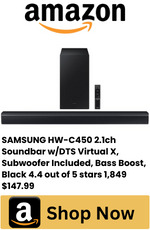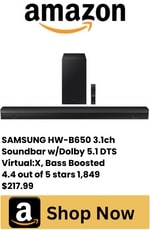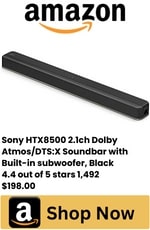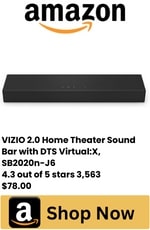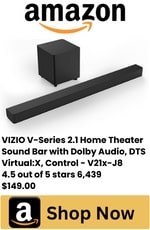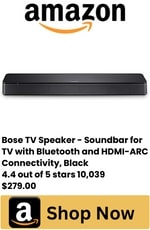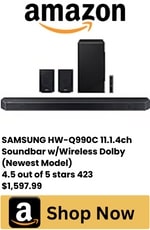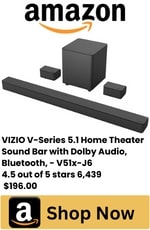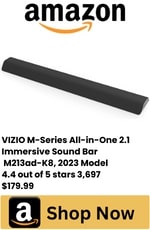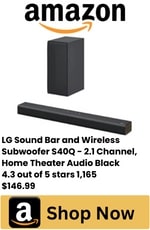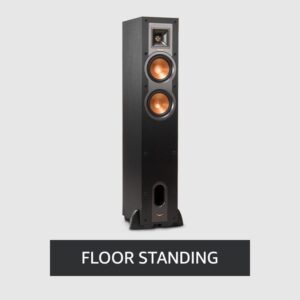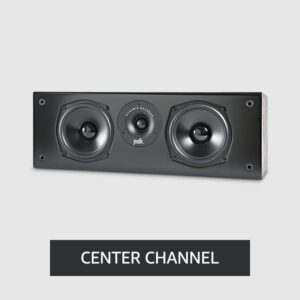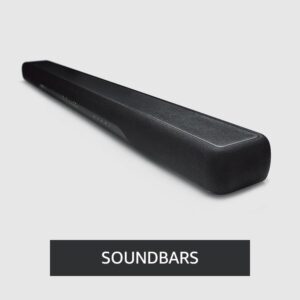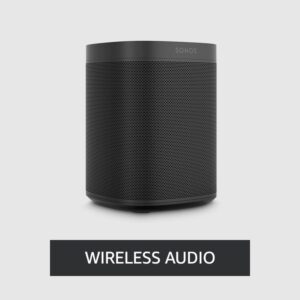How To Connect Soundbar To Tv Without HDMI | 4-Ways
A soundbar is usually connected to a TV using HDMI or digital optical audio connection. They may even improve your listening experience if they transmit audio without degrading its quality. However, what if your device is not compatible with either of these?
With no HDMI or optical ports, you can connect your Soundbar to the TV with a wireless connection or use 3.5 mm aux, RCA, or coaxial cables for a mid-tech connection. Using an auxiliary device, coaxial cables can be converted to other connections.
It’s common to need creativity, mixing and matching, and a few adjustments to connect your Soundbar to your TV. Stay tuned for a detailed look at your options, and start setting up the same setup yourself.
1. Connect with Aux or 3.5mm Cable
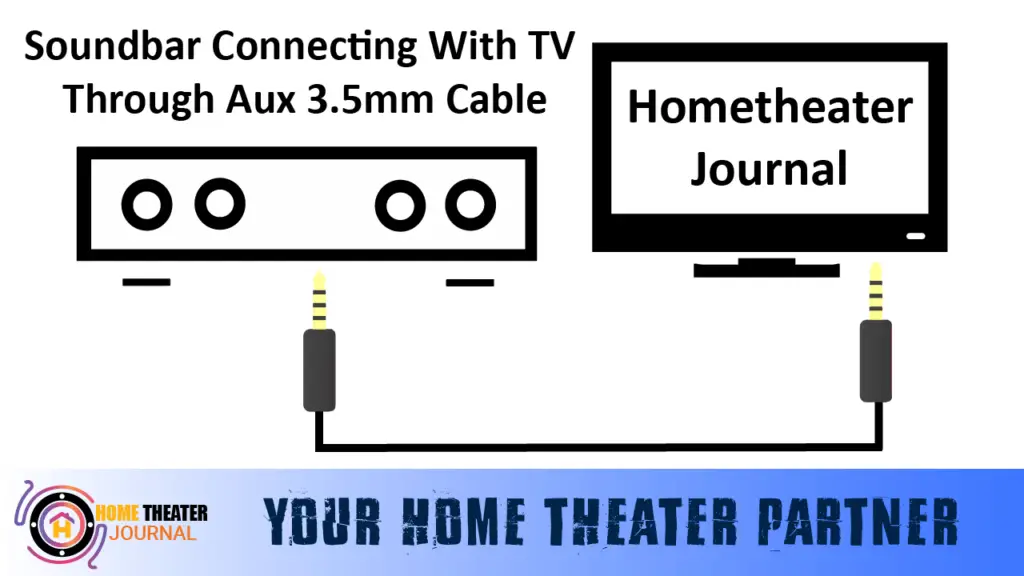
If your TV does not support both HDMI and digital optical, you would want to connect a soundbar to it.
Auxiliary cables and auxiliary inputs are almost always the only way to transmit audio signals from old TVs. Mobile phones and other audio devices have the same type of connection.
If your TV supports this connection, a nylon braided aux cable from Syncwire (Amazon link) is good. All devices that support 3.5mm jacks are compatible with it. A 24K gold-plated connector ensures lossless transmission of audio signals and improves the device’s reliability.
However, it is possible to use an aux to RCA converter if the TV or Soundbar you are using does not support this type of connection. These converters use cables that are much cheaper than HDMI or optical cables.
There are a few reasons why the AmazonBasics 3.5MM to 2-Male RCA Adapter (Amazon link) would be a great option since it comes without fancy features and is corrosion-resistant. It’s also extremely inexpensive but will make your life easier.
Most of the soundbars available today support the connection of an auxiliary device using an auxiliary 3.5mm jack. Therefore, you do not have to possess any technical knowledge on using an aux cable to connect to a TV.
The cable costs less than $10, so it’s an inexpensive alternative. However, using this connection for audio isn’t the best solution since you will have to deal with some problems.
Cons of Auxiliary Cables
A 3.5mm aux cable can transmit sound without a noticeable drop in sound quality. Auxiliary cables, however, can only output sound in stereo. Using soundbars with three channels, four channels, or more is impossible because the device only works with left and right speakers.
Using only left and right speakers will still result in good audio. However, there is a downside to using an aux cable to hear surround sound effects because an aux cable cannot send signals to the frequencies that create the effect.
A 3.5mm aux cable is a great alternative if you only want to connect your Soundbar to your TV. In contrast, investing in a new TV or going wireless would be a good idea if you want to make a media room with a sound that will make your heart race.
2. To Connect, Use Three RCA Cables (Yellow, Red, and White)
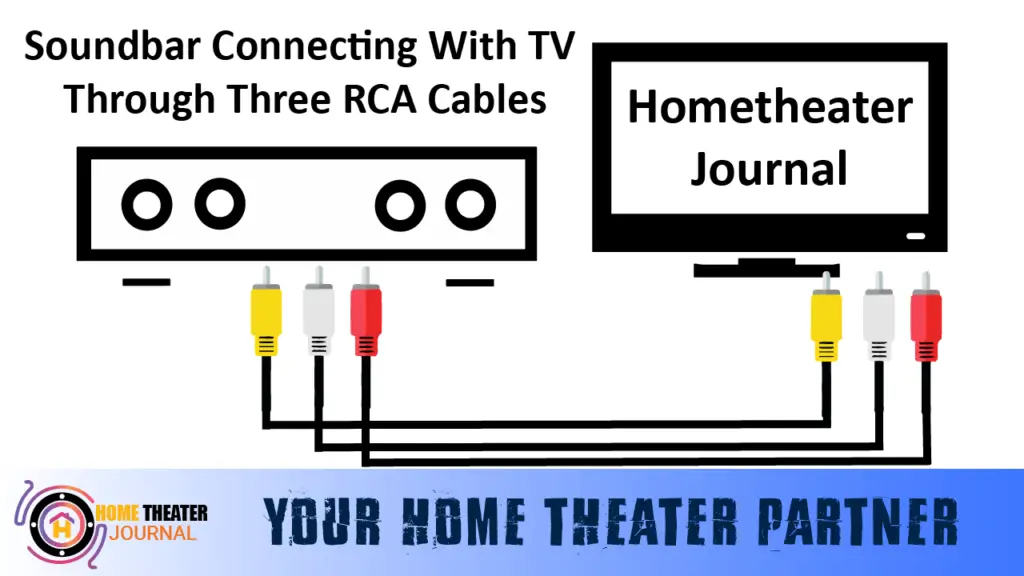
3.5mm, HDMI, and optical connections are compatible with most TVs these days. If you have an older TV, RCA, and coaxial cables are your only audio options. These cables are available in many electronic stores and can transmit audio signals effectively.
When it comes to soundbars, you’re in luck if your TV has RCA cables since most models now support two-channel audio. RCA cables must have RCA audio outputs on the TV and the cable before being used.
The yellow video cable should go into the TV port; the white and red audio cables must run directly into your Soundbar. If you only have one HDMI cable with input ports, you can fix that by connecting the yellow video cable.
These days, many TVs can provide both input and output for audio and video signals, serving as a central hub for processing audio and video signals. However, older TV sets only allow you to receive audio and video. You have to split the signal before it reaches the TV if you’re going to connect a soundbar to a TV with RCA cables.
Using an RCA connection with a soundbar is straightforward with the Monoprice Premium 2 RCA Plug (Amazon link). There are only two audio connectors – red and white. Using your sound bar and TV together eliminates the need for a yellow video connector.
For a more detailed guide on connecting a Vizio soundbar to a TV and exploring better audio connection options, check out this comprehensive resource How to Connect Vizio Soundbar to TV.
Cons of RCA Cables
Audio signals are only transmitted left and right on RCA cables, just like auxiliary inputs. The best audio juice will not be available if you consider buying a soundbar with at least 3.0 channels.
RCA can be an inexpensive alternative if you only wish to connect your Soundbar to a TV without needing high-resolution audio.
The RCA output on your TV will not enable surround sound even if it has 5-channel output. Because soundbars only work with HDMI, optical audio cable, or wireless connections, those working at three channels or higher can only support these connections.
An adapter such as the Mini RCA Composite CVBS (Amazon) adapter can help solve this problem and let you produce better audio quality without having to upgrade your TV.
To take advantage of the benefits of this device, you do not need to make a major investment in upgrading your TV to enjoy 3 or more channels. Because older televisions cannot produce true high-definition audio signals, it is impossible to get true surround sound effects.
Nevertheless, this is a neat trick to instantly upgrade your sound system without using the latest digital connections.
How to Connect a Soundbar Without HDMI ARC
You can use other audio connection options such as optical, RCA, or 3.5mm AUX cables to connect a soundbar without HDMI ARC.
Here’s how to do it:
- Check if your TV and soundbar have the same audio output ports.
- Turn off both devices and plug in the cable to the TV’s audio output port and the soundbar’s audio input port.
- Turn on the TV and soundbar and switch the soundbar to the appropriate input source.
- Adjust the audio settings on your TV to output sound to the connected soundbar.
These alternative audio connections can still deliver quality audio, but it’s important to check the soundbar’s specifications and ensure that it supports the audio connection method you plan to use.
3. Connect with Coaxial Cable
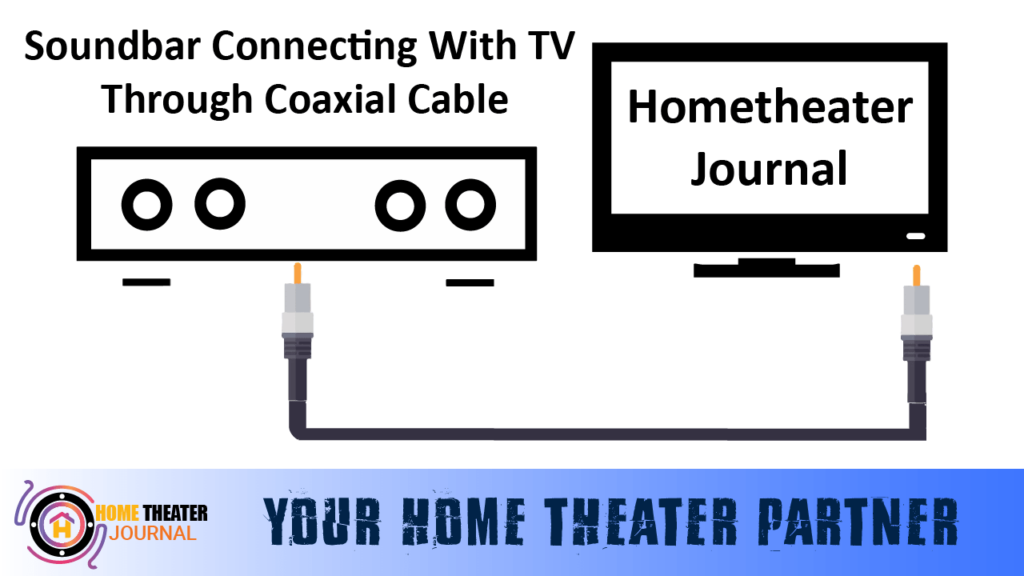
Possibly, you only have one option for your older TV – coaxial cable. Televisions in the past could only play cable programming since they were hooked up to cable. The cable you connect to your TV will send audio and video directly to the TV and the cable provider.
Many devices still use coaxial cable connections even though some say it is outdated. You will see a wire sticking out of the cable attached to a cable with a nut attached to both ends.
Using a coaxial cable to connect your Soundbar to the TV requires a VCR or DVD player. Videotapes and video discs are played on these devices. If you want to use a coaxial cable to establish an audio connection, this is your best option (or probably the only one).
Coaxial cables can be connected to the VCR output and the TV input, with one end plugged into the TV output and the other into the VCR output. You can then connect RCA cables to the Soundbar to output the audio from the VCR or DVD. The TV will only serve as a monitor, and you’ll remove all its features.
Coaxial cables can also be used with other options, but these are often too cluttered and expensive to be worthwhile. The adapter also requires external power, so you can’t use it with a coaxial cable. After connecting these devices and devices, you might already have a cluttered and cumbersome setup.
It would be better to invest the cash into an HDMI-capable modern TV rather than an old one with an adapter and external power source.
Cons of Coaxial Cable
Though tricky, you can connect a sound bar to a TV using a coaxial cable. Unfortunately, your TV and Soundbar cannot connect your devices since they are outdated.
In addition, it may be challenging to locate an electronic store with a VCR or DVD player if you don’t have one at home.
You will also have a hard limit on how many channels you can use when using this type of connection.
AV RCA to HDMI adapters can also be used with VCRs that have a 5-channel connection, but, unfortunately, they won’t be able to transmit accurate high-definition audio.
4. Wireless
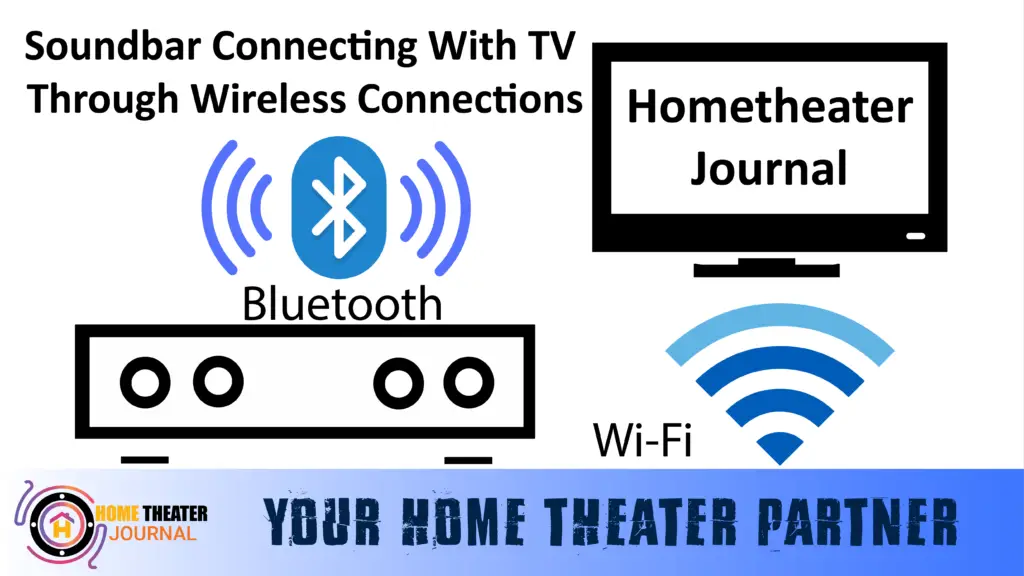
Unfortunately, optical, HDMI, and USB audio connections are not always the best options. We could even upgrade your existing Soundbar to go wireless. Your Soundbar can produce excellent sound without the need for a wired connection.
In addition to the fact that some wireless conversion kits (my top picks) are compatible with aux or RCA cables, this option is even more attractive. Consequently, you do not need a new TV if it only supports auxiliary jacks or RCAs. You can still get wireless capabilities on an old TV!
It isn’t necessary to spend your time looking for ugly converters to convert your old audio connection to HDMI anymore. Instead, you can buy wireless conversion kits to provide your devices with the same reliable connection.
Moreover, installing the Soundbar will also be a lot easier since there will not be a need to connect a different device to the TV to make the connection. It is as simple as connecting the transmitting device to your television and the receiver to your Soundbar, and then you can enjoy it! This tool will be handy even if you’re trying to hide the cables connecting the computer to the other components!
Wireless speaker connections
These kits can be used as plug-and-play devices with a TV and sound bar. In the meantime, you should become familiar with the types of wireless speaker converters you can purchase before trying to find the best you can use.
Your TV may not have to be upgraded to take advantage of your Soundbar. You will know what setting suits your set-up best, which may help you pick the best Soundbar.
You can connect a soundbar to a TV using the following wireless connections:
- Bluetooth®: There are several types of speaker conversion kits, but generally, you will find Bluetooth®, which is the most common type of connection. Using two devices, two transmitters and two receivers can be connected to a wide range of devices using HDMI, optical, aux, or RCA cables. Using a Bluetooth® connection, audio signals are sent from the transmitter to the receiver. The TV, in a nutshell, becomes a Bluetooth® device. The Bluetooth® connectivity will be available to all the models, including those that only connect using RCA.
- Qualcomm’s aptXTM: In addition to Bluetooth®, Qualcomm’s aptXTM technology uses only high-quality audio transmissions. Using RCA cables, you can still accommodate your TV using true high-definition audio signals, even when your TV can only connect via RCA cables.
- Radiofrequency: The wireless conversion kits can also establish connections using radio frequencies. Better coverage is usually provided by devices using the 2.4 GHz band. Several more advanced conversion kits use frequency hopping to minimize interference from interaction with other devices that work on the same frequency.
- WiFi: To give your TV wireless capabilities, you can use WiFi, the least common type of connection. Audio signals are transmitted over the Internet by the transmitter. After downloading the uncompressed audio signals, the receiver can output them to the speaker via the output unit. As a result, this latency is highly dependent on Internet speed, so it may not be able to produce the best sound quality. As a result, if your connection is faster, you will have better audio quality.
For TVs that only support coaxial cables, you can use RCA, auxiliary, optical, or HDMI, but not if your TV has RCA, auxiliary, optical, or HDMI connectors. The best way to connect a soundbar to a TV is via wireless conversion kits since they cover most TV connections that we have today.
Wireless Connections: Pros and Cons
Almost any device can be connected through wireless technology, which is not cheap. To decide whether or not to have one, you must know both the pros and cons of using one. Wireless speaker conversion kits offer the following benefits:
- They allow you to create a more open space. Long, messy cables persist regardless of whether you use digital optical or HDMI for audio connections. A world increasingly relying on wireless connections might consider this a huge disadvantage. If you plan on using conversion kits, you don’t need to install cable connections or keep them hidden.
- You will have more channels at your disposal. We’ve discussed several ways to connect one speaker to another, but all of those have one major drawback-limited support for speakers with 3.0 or higher channels. You can get surround sound effects with a wireless connection because it does not require complicated configuration.
- It features a coaxial connection as the only exception to all-in-one connections. These connections can be used to go wireless, including HDMI, optical, 3.5 mm, and RCA. Therefore, regardless of the options that your TV supports, you’re most likely to configure a wireless connection.
- A lossless audio connection is available. The airwaves hardly affect the sound quality since it transmits audio signals.
Even though wireless kits offer many benefits, they are still far from perfect. You need to be prepared for the following problems to connect your Soundbar to a TV:
- Wireless speaker conversion kits are a bit more expensive. While cheaper options may be available, you may have to invest in more expensive models if you want the most out of your TV and Soundbar.
- Connectivity is not 100% cable-free. Because your TV still needs to be connected to the transmitter, and your sound bar needs to be connected to the receiver, you can only minimize the length of cables you need.
- There are many ways to connect wireless conversion kits, but none are error-free. Even Qualcomm®’s aptXTM has a limited range, so even the best connection is limited. Using cables for connection would be better if you plan on using them to connect large spaces.
Conclusion
HDMI and digital optical may dominate an audio connection, but these aren’t your only choices. You still have the opportunity to use the following methods if your television does not support both the HDMI and the AV connections:
- Connect with Aux or 3.5mm Cable
- To Connect, Use Three RCA Cables (Yellow, Red, and White)
- Connect with Coaxial Cable
- Wireless
Wireless audio is available in all of these options. Depending on your TV, you may be able to use a different type of connection. The Wireless Speaker Conversion Kits will solve the problem of setting up cables when you don’t want to deal with that hassle!
FAQ’S
Q: What are the alternatives for connecting a soundbar to a TV without HDMI?
A: You can connect your soundbar to your TV using an optical cable, RCA cable, a 3.5mm auxiliary cable, or via Bluetooth if your soundbar and TV support it. Each method has its own advantages and disadvantages, so choose the one that works best for your setup and preferences.
Q: How do I connect a soundbar to a TV with an optical cable?
A: First, ensure your soundbar and TV have optical audio ports. Then, connect one end of the optical cable to the soundbar and the other to the TV. Next, adjust the audio settings on your TV to output audio through the optical port, and you’re good to go.
Q: Can I use RCA cables to connect my soundbar to my TV?
A: If both devices have RCA audio ports, you can connect your soundbar to your TV using RCA cables. Connect one end of the RCA cables to the soundbar and the other to the TV, and then adjust the audio settings on your TV to output audio through the RCA ports.
Q: How do I connect a soundbar to a TV using a 3.5mm auxiliary cable?
A: First, ensure that your soundbar has a 3.5mm auxiliary input and your TV has a 3.5mm headphone jack. Then, connect one end of the auxiliary cable to the soundbar and the other to the TV’s headphone jack. Finally, adjust the audio settings on your TV to output audio through the headphone jack.
Q: Can I connect my soundbar to my TV via Bluetooth?
A: If your soundbar and TV support Bluetooth, you can connect them wirelessly. Pair your soundbar and TV using the Bluetooth settings on each device, and you’re good to go. However, remember that Bluetooth audio sometimes has latency issues, so it may not be ideal for watching videos or playing games.

Author: Baqarrasheed
I know all about home theater items! I have been doing this for more than three years now. I am good with things like sound systems, TVs, projectors, and all that cool entertainment gear. I like to help folks by testing and talking about these gadgets on Hometheaterjournal. I want to make sure everyone can create an awesome entertainment setup at home without any confusion.
I write the creative content for HometheaterJournal.



